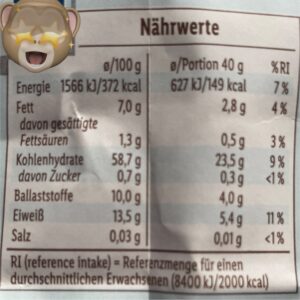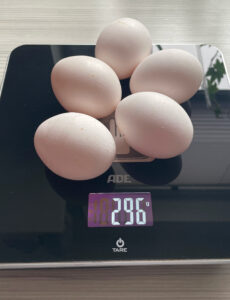Welcome to the NutriCount guide!
How to correctly calculate the calories and proteins in your food
On this page, we will show you the most accurate and precise way to calculate the calories and proteins in the food you consume. Despite modern and advanced calorie-counting apps, this classic method remains the simplest and most effective! It can be applied to any food, guaranteeing you accuracy without unnecessary complications
Before you start, weigh your food for more precise results.
To get the most accurate results, it is important to measure your food with a kitchen scale. Estimating portions “by eye” can be inaccurate. By measuring your food, you can ensure that you are calculating the exact nutritional values, making it easier to achieve your specific goals!
Once you have measured the values, simply use a calculator for a quick and easy calculation of calories and proteins. This classic approach is the simplest and most effective, without the need for complex apps – just precise numbers that help you stay on the right track!
1. What you need to know about food labels
On most food packages, you will find nutritional information displayed per serving (for example, per 100g, per 40g, or per 1 cup). For this example, let’s assume that the label on oatmeal shows the following:
Calories: 149 kcal per 40 grams
Proteins: 5.4g per 40 grams
This means that for every 40 grams of oats you consume, you will get 149 kcal and 5.4g of protein.
Calories: 149 kcal per 40 grams
Proteins: 5,4g per 40 grams
This means that for every 40 grams of oats you consume, you will get 149 kcal and 5.4g of protein.

2. Adjusting the nutritional value based on portion size
Often, the packaging provides nutritional information for a specific serving size, but you may want to calculate the nutritional values for a different amount of food. Let’s assume you are using 60 grams of oats instead of the 40 grams listed on the label. To calculate the calories and proteins for 60 grams of oatmeal, we will use the following formula:
Calories = (149 kcal ÷ 40 g) × 60 g = 223.5 kcal
3. Example: Calculating for 60 grams of oatmeal
Here’s how you can calculate the calories and proteins for 60 grams of oats:
Calories: If the label shows 149 calories for 40 grams, we apply the following formula:
149 kcal ÷ 40 g × 60 g = 223.5 kcal
Similarly, we calculate the amount of protein for 60 grams of oats. The label shows 5.4g of protein per 40 grams, so:
5.4g Protein ÷ 40 g × 60 g = 8.1g Protein

Example 2: Calculating calories and proteins for 296 grams of eggs

Calories:
Let’s assume that 100 grams of eggs contain 150 kcal. If you don’t have the label, you can easily find this information through Google. To calculate the calories for 296 grams of eggs, you can use this simplified formula:
150 kcal ÷ 100 g × 296 g = 444 kcal
So, 296 grams of eggs contain 444 calories.
Proteins:
Similarly, let’s assume that 100 grams of eggs contain 12.5 grams of protein (which is a common value). To calculate the protein content for 296 grams, you can use this simplified formula:
12.5g Protein ÷ 100 g × 296 g = 37g Protein
So, 296 grams of eggs contain 37 grams of protein.
Make sure to accurately measure and count the nutritional values for every ingredient you consume.
4. NutriCount – Your Daily Guide for Nutrition and Hydration
Once you’ve calculated the calories and proteins, simply enter them into the NutriCount app and track your daily intake. Additionally, you can track your hydration throughout the day. At the end of the day, you’ll have an accurate overview of your calorie and protein intake – which is key for shaping your body and achieving your fitness goals!
5. Why is this important
Understanding how to calculate nutritional values based on the amount of food you consume is crucial for accurately tracking calorie and protein intake. This helps you to:
- Achieve specific goals such as weight loss, muscle gain, or maintaining a balanced diet through precise tracking.
- Manage your diet without guessing, avoiding miscalculations of your food intake.
- Stay consistent with your daily intake using a simple formula and calculator, without the need for complex tools.
Accurate tracking is key to achieving your health and fitness goals, and this method makes it easier!